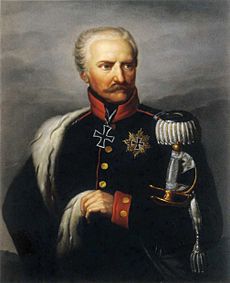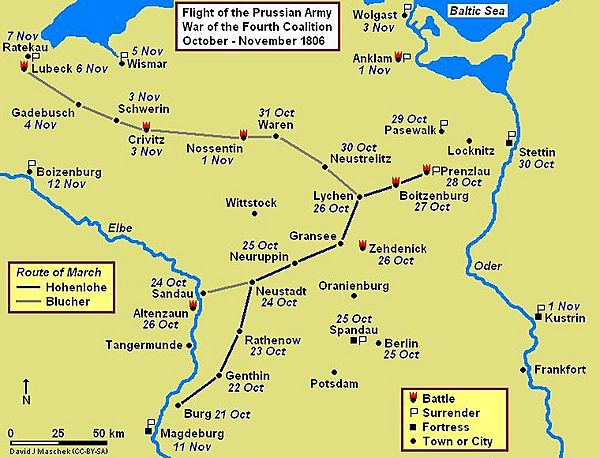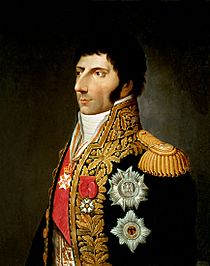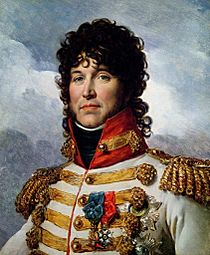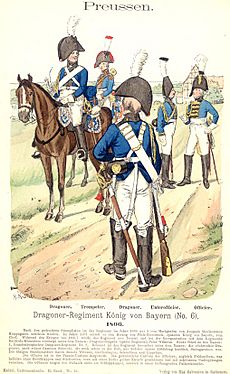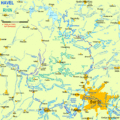Battle of Lübeck facts for kids
Quick facts for kids Battle of Lübeck |
|||||||
|---|---|---|---|---|---|---|---|
| Part of the War of the Fourth Coalition | |||||||
 The battle where Bernadotte and Blücher met. |
|||||||
|
|||||||
| Belligerents | |||||||
| Commanders and leaders | |||||||
| Strength | |||||||
| 30,000-35,000 90 guns |
Prussia: 17,000 52 guns Sweden: 1,800 Total: 15,000-18,800 52 guns |
||||||
| Casualties and losses | |||||||
| 1,500-2,000 killed, wounded or captured | 6,000-9,000 killed, wounded or captured
9,000 surrender in 7 November |
||||||
The Battle of Lübeck happened on November 6, 1806, in Lübeck, Germany. It was a major fight during the War of the Fourth Coalition. Prussian soldiers, led by Gebhard Leberecht von Blücher, were trying to escape after a big loss at the Battle of Jena–Auerstedt. They were chased by French troops under Marshals Murat, Bernadotte, and Soult.
The French won a huge victory, forcing the Prussians out of the neutral city of Lübeck. Lübeck is an old port city on the Baltic Sea, about 50 kilometers (31 miles) northeast of Hamburg.
After their crushing defeat by Napoleon in October, the Prussian armies moved east. They hoped to reach the Oder River. Napoleon wanted to destroy them completely. He sent his large army, the Grande Armée, to chase them. Many Prussians hid in the Magdeburg fortress, where they were surrounded. Another group was caught and defeated in the Battle of Prenzlau. This led to many Prussian troops and fortresses giving up.
Blücher couldn't reach the Oder River. So, he turned west, with Murat, Bernadotte, and Soult still chasing him. After several smaller fights, Blücher's troops entered the neutral city of Lübeck. They set up defenses there. Bernadotte's soldiers broke through the city's northern defenses. They also overwhelmed the troops fighting Murat and Soult. Blücher barely escaped the city, but most of his officers were captured. The Prussians suffered huge losses. The French soldiers looted Lübeck during and after the battle. The next day, the French trapped the remaining Prussians near the Danish border. Blücher was forced to surrender.
Danish forces, led by Johann Ewald, were also nearby. They were at the Danish-Prussian border. Their job was to stop any French or Prussian forces from entering Denmark. This was to protect Denmark's neutrality. The Danish forces did not join the main fight. They had only a few small clashes and talks with both sides. During these talks, Ewald himself was briefly held by the French.
The French captured a small group of Swedish soldiers during the battle. Bernadotte treated these Swedish officers and soldiers with great kindness. This good treatment later helped him become the Crown Prince of Sweden. This happened almost four years after the battle.
Contents
What Led to the Battle?
The Great Chase Begins
On October 14, 1806, Napoleon's army badly defeated the Prussian armies. This happened at the Battle of Jena-Auerstedt. After this big loss, the Prussian army broke into smaller groups. One group, led by General Frederick Louis, Prince of Hohenlohe-Ingelfingen, retreated through the Harz Mountains. Another group of 12,000 men, led by General-Leutnant Blücher, followed Hohenlohe.
On October 17, Marshal Bernadotte's I Corps attacked a Prussian reserve force at the Battle of Halle. This Prussian force then joined Hohenlohe at Magdeburg. Marshals Soult and Murat arrived and surrounded Magdeburg. Hohenlohe refused to surrender. He then marched northeast, trying to escape. Blücher also moved northeast, crossing the Elbe River on October 24.
Trapped and Pursued
Hohenlohe planned to destroy bridges to protect his army. But French cavalry captured Oranienburg before his men could get there. On October 26, Marshal Murat defeated a Prussian group at Zehdenick. The Prussians fled towards Stettin. The next day, Hohenlohe fought through a French roadblock.
On October 28, Murat attacked the Prussians at the Battle of Prenzlau. French dragoons broke through Hohenlohe's column. The Prussian rear guard was then forced to surrender. Murat then tricked Hohenlohe into giving up, even though he wasn't fully surrounded. About 10,000 Prussian soldiers, 64 cannons, and 1,800 horses were captured.
The next day, 4,000 more Prussians surrendered at Pasewalk. That night, French cavalry tricked the commander of Stettin fortress into surrendering. Over 5,000 troops were captured there. Many smaller Prussian groups were also captured. By November 1, the fortress of Küstrin also surrendered.
Marshal Soult crossed the Elbe River and headed northeast. Bernadotte captured Prussian supplies and cannons. He learned that Blücher was heading towards Waren.
Blücher's Last Stand
On October 31, Blücher and another Prussian commander, Winning, met near Waren. Winning wanted to escape to the port of Rostock. But Blücher decided to go back across the Elbe River at Boizenburg. He hoped to join other Prussian forces there. Blücher divided his army into two groups. Winning led 11,000 men, and Blücher led 10,000.
By this time, about 47,000 French soldiers were chasing Blücher. Bernadotte pushed ahead with his fastest 12,000 troops. Murat and his cavalry were also moving quickly from their victories.
On November 1, the Prussians left Waren. Blücher moved northwest, with a rear guard protecting him. Winning marched west. The Prussians fought bravely against French cavalry and infantry near Waren. They managed to retreat in good order.
On November 3, a Prussian rear guard fought at Crivitz. The French, led by General Maison, pushed the Prussians out of the village. The Prussians fell back, but their dragoons charged and pushed back some French cavalry. Bernadotte himself had to hide inside a group of infantry. Later that day, the French captured the village of Meuss. They also cut off and destroyed a Prussian infantry battalion at Pinnow.
By November 4, Murat and Soult were close behind Bernadotte. Blücher decided to move from Schwerin to Gadebusch. He was joined by more Prussian troops. On November 5, French cavalry caught another Prussian force at Wismar. They captured 367 Prussian cavalrymen.
Blücher's army was now only about 16,000 to 17,000 soldiers. Even though he had 100 cannons and a strong position at Gadebusch, his troops were tired and hungry. He decided to retreat to the neutral city of Lübeck. He hoped to meet a group of Swedes there. The Prussian army arrived at Lübeck on the morning of November 5. They forced their way through the southern gate and took over the city. Blücher demanded food and money from the city leaders. He promised not to fight inside the city.
A group of 1,800 Swedish soldiers had been in Lübeck since October 31. They were waiting for ships to take them home. But strong winds kept their ships in the Trave River. Bernadotte sent troops to capture them. On November 5, Soult attacked one of Blücher's rear guards near Lübeck. He also captured 300 Prussians at Ratzeburg. Soult and Murat were ready to attack Lübeck from the south. A Danish force was also nearby, ready to defend Denmark's neutrality.
The Fight for Lübeck
Most of Blücher's army spent the night inside Lübeck. Blücher placed troops to protect his flanks. His rear guard stayed outside the northern gate. Lübeck used to have strong defenses, but many were taken down by 1806. Still, the wet ditches in front of the old walls were a big problem for attackers.
East of the Trave River, there were three gates into the city. The northern gate was the Burgtor. The southern gate was the Mühlentor. The eastern gate was the Hüxtertor. On the west side of the Trave, there was only one gate, the Holstentor. The Wakenitz River protected much of the eastern side of the city.
At the Burgtor, Blücher placed ten cannons and other infantry. He also put four cannons on the Bellevue bastion on the west bank. This allowed them to fire at attackers from two sides. Blücher put General Frederick William, Duke of Brunswick-Wolfenbüttel in charge of the Burgtor area. He defended the Mühlentor with several battalions and cannons. The Hoxtertor was also defended. In total, 17 battalions and 52 cannons defended Lübeck. When city leaders reminded Blücher of his promise not to fight in the city, he refused, saying he would fight.
The Attack Begins
Bernadotte's army started marching at 2:00 AM. They quickly captured a Prussian convoy with 1,000 troops and 300 wagons. Meanwhile, French troops captured 600 Swedes near Schlutup.
At 6:00 AM, Murat and his cavalry attacked the Prussians near the southern gate. They captured 200 soldiers and chased them into Lübeck. The cannons at the Mühlentor pushed back the French cavalry. Soult's army arrived, and their cannons began firing at the southern gate.
Soon after, Bernadotte's leading troops pushed the Prussian rear guard back towards the northern gate. French soldiers quickly took a hill east of the Burgtor and set up cannons there. Bernadotte sent his troops to attack the St. Gertrude Church. At first, the French were stopped. But then they captured the churchyard. However, cannons from the Bellevue bastion caused heavy losses.
The French 94th Line Infantry Regiment then charged forward. Hidden by the smoke, they captured a small fort and then the main cannon position. Around 1:00 PM, the Prussian defenders fled through the Burgtor, with the French right behind them. Bernadotte sent his troops to capture the bridge over the Trave River and to attack the Mühlentor from behind. Other French troops crossed the Trave and forced the Bellevue cannons to retreat.
Fighting in the City
Blücher thought his northern defenses were safe. He went to his headquarters near the Mühlentor. But he was surprised by French soldiers and barely escaped. His chief of staff, Gerhard von Scharnhorst, and other officers were captured. Meanwhile, the French fought their way through the market square and main streets. There was fierce street fighting, and many Prussians were killed or wounded. Blücher tried to rescue his staff but failed. He then escaped across the Trave River to safety.
Soult sent his troops to capture the Hoxtertor and the Mühlentor. The Prussians defending the Mühlentor were attacked from behind by Bernadotte's troops. They fought hard but suffered heavy losses. Finally, 2,000 Prussians surrendered. Murat's cavalry then rushed through the gate and into the city streets. Next, the Hoxtertor's defenders were surrounded and forced to surrender after heavy losses. By 3:30 PM, the French controlled Lübeck, though some fighting continued.
Blücher tried to organize another attack. He sent a regiment to attack the Holstentor. But French troops already held the bridge and western defenses. The French pushed back the Prussians with heavy losses. French troops then chased the Prussians out of the city.
The Aftermath
The French leaders estimated that the Prussians lost 3,000 killed and wounded in Lübeck. They also captured 5,000 to 6,000 Prussian soldiers. Some historians say the Prussians lost 2,000 killed and wounded, and 4,000 captured. Three Prussian infantry regiments were completely destroyed. The French had between 30,000 and 35,000 soldiers in the battle. The Prussians and Swedes also lost 24 flags, two standards, and at least 50 cannons. French losses were about 1,500 killed and wounded.
After storming the city, the French soldiers looted Lübeck. There were many acts of theft and violence. Bernadotte and other officers tried to stop their men. Bernadotte even used his sword to defend some houses. But the soldiers were out of control. Historians agree that the troops committed terrible acts. Some historians note that Blücher's choice to fight in a neutral city made him partly responsible for the looting.
The next morning, Blücher was at Ratekau, north of Lübeck. He had only about 4,050 infantry and 3,760 cavalry left. On November 1, he had 21,000 men. In front of him were three French marshals with up to 35,000 soldiers. To his left was the Trave River, behind him was the Baltic Sea, and to his right was the Danish border, guarded by Danish forces.
Since there was no hope, Blücher asked for terms to surrender. He was told he had to surrender his soldiers as prisoners of war. He sent a note saying he was surrendering because he had no food or ammunition left. Murat refused to accept it. He said Blücher had to surrender to all three marshals and couldn't give a reason for surrendering. Blücher then surrendered to Bernadotte, Soult, and Murat. He was allowed to add a note at the end of the document. He wrote:
"I capitulate, since I have neither bread nor ammunition - BLUCHER."
Blücher surrendered with about 8,000 to 9,000 men and 80 cannons. This was all that was left of his army. Many Prussian units lost their flags during the battle.
On November 8, the Prussian group at Travemünde surrendered. Other Prussian forces were also captured in the following days.
Bernadotte's kind treatment of the captured Swedish officers, especially Colonel Count Gustave Mörner, was noticed by the Swedish authorities. Bernadotte treated Count Mörner with great respect, even letting him stay in his own home while he was a prisoner. This good treatment helped Bernadotte become very popular in Sweden. Later, in 1810, Bernadotte was chosen as the Crown Prince of Sweden. In 1818, he became King Charles XIV John of Sweden.
Images for kids


